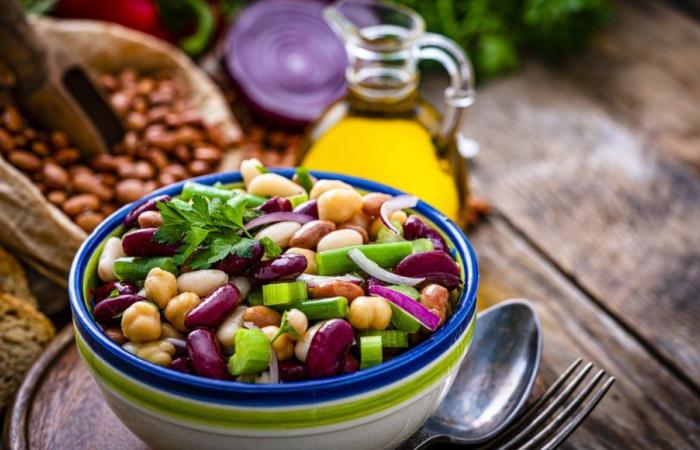Protagonists of slimming diets considered more effective and for this reason often demonized by nutritionists due to the potential damage of excessive income, there is a lot of confusion about proteins, especially in a historical phase in which even what we eat pay attention to environmental sustainability and As a result, alternative protein sources to meat are being sought. But what are the other protein sources? Do vegetables and carbohydrates contain a certain amount? And in the summer with the heat that takes away your appetite, how can you ensure the right amount?
Vegetable protein sources
When we talk about proteins we think above all of meat, fish, eggs, legumes and dairy products. Yet, these precious macronutrients are also in wheat and to a small extent also in vegetables. Just under 30% of the proteins we eat come from cereals and derivatives, around 27% from meat or fish, 21% from dairy products. All foods that are part of our Mediterranean diet which represents a nutritional model that brings together different dietary habits historically followed in the countries of the Mediterranean basin. It’s a shame that we Italians are abandoning it a bit.
According to a study by Crea Alimenti e Nutrizione, published in the scientific journal “Frontiers in Nutrition” and based on a sample of 2869 people, in Italy only 13% of the population today follows the principles of the Mediterranean diet. And the volume of the Danone Institute Foundation “Proteins in the Mediterranean diet” is dedicated to this dietary model, edited by science journalist Federico Meretapublished by Gribaudo and supervised by a scientific team of experts such as Lorenzo Morelli, Elisabetta Bernardi, Andrea Ghiselli, Maurizio Muscaritoli, Michele Sculati and Assunta Filareto.
Nutrition: more vegetable proteins and eggs are no longer a taboo. What changes with the new guidelines
by Irma D’Aria
05 June 2024
Ideal consumption
The Guidelines for correct nutrition in Italy recommend a balanced consumption of animal and vegetable proteins: as part of a healthy lifestyle, the ideal protein intake should derive 45% from animal proteins and 55% from proteins vegetables.
Among the sources of animal proteins, the largest contribution should come from dairy products, due to their fundamental contribution of calcium, and from fishery products, while meat should make up 10% of our diet. “The need for proteins – he explains Michele Sculati, specialist in Food Science, professor at the University of Pavia and Milan Bicocca – increases in sports, in a percentage ranging from 20% up to 100% in athletes at a competitive level, in particular training situations. For those who play sports, the increase in energy expenditure – and therefore in calories consumed every day – leads to a systematic increase in protein quota”.
How to compose the dish
But this must happen in a varied and balanced diet, with a correct proportion of carbohydrates, proteins, fats, fibers and other key nutrients. “We should compose a dish every day that is made up of half fruit and vegetables, a quarter cereals and a quarter proteins of both animal and plant origin, therefore alternating them so that in this way we have the completeness of our nutritional requirement of amino acids essential which are the bricks to build the proteins we need every day”, he explains Elisabetta Bernardispecialist in Food Science and teacher of the Advanced Course in Human Nutrition, University of Bari. “If we don’t take in enough, we’re going to affect the functional reserves, which means we’re going to attack the muscle.”
Animal and vegetable proteins
But what is the difference between animal and plant-based proteins? Proteins of animal origin have a high biological value, that is, they are more easily digestible and absorbable by the body and an important quantity of essential amino acids, constituents that human beings can only obtain by eating. On the other hand, plant proteins are linked to lower overall mortality, particularly cardiovascular, and better insulin sensitivity, i.e. the body responds better to insulin regulation of blood sugar.
Anti-aging muscle proteins
What makes this nutrient so precious for our diet are its many functions, starting with the one we all associate them with: muscle mass. Muscles account for 40% of our body weight (unless their mass increases with training) and we have more than 600 of them.
“Aging – he explains Maurizio Muscaritoli, president of the Italian Society of Clinical Nutrition and Metabolism (SINuC) – is physiologically associated with a reduction in muscle mass: after the age of 40 the rate of loss is estimated at around 8% every ten years, while after the age of 70 the rate rises to 15% for each decade. In addition to natural physiology, there are other factors that accelerate the progressive and generalized loss of muscle mass, with consequent reduction in strength and physical performance, as well as quality of life: this is sarcopenia. An adequate distribution of the protein quota at meals, with a protein intake in at least two main meals and physical rehabilitation represent a potentially effective strategy in combating sarcopenia in old age”.
Proteins and longevity
But proteins also have a fundamental plastic function: they build, repair and maintain the well-being of cells and tissues which, also thanks to them, are constantly replaced. There is a clear connection between protein consumption and health and, specifically, between protein consumption and overall survival. There is scientific evidence showing that increased protein intake may be inversely associated with mortality. In particular, in the over 60s thanks to their protective effects on muscle strength, fragility and immune responses. Analyzing the data, these statements are not generalizable to all protein sources.
The satiating stimulus of proteins
And then there is the satiety effect which has always made proteins the protagonists of slimming diets. The amount of proteins present in a food increases the time it remains in the stomach, and this becomes a potential conditioning for oral processing (from the first bite to swallowing), resulting in a greater satiating stimulus.
A protein-rich meal, combined with the right amount of carbohydrates, stimulates the release of the GLP-1 hormone which slows the emptying of the stomach, increases the feeling of satiety and reduces appetite even afterwards. After having lunch there is an energy expenditure linked to digestive processes. The amount of energy lost in heat is greater after consuming proteins. The hypothesis has been put forward that satiety can be effectively induced by the branched chain amino acids (leucine, isoleucine and valine) present in high quality proteins.
To explain the satiating effect of proteins, their role in the induction of postprandial gluconeogenesis (glucose production) is also discussed.
WHO, unhealthy diets cause 8 million deaths: yes to the Mediterranean model
July 26, 2023
How to consume proteins in summer
When the heat of summer arrives, especially the elderly but also children find it more difficult to consume the right amount of proteins. What to do then? “First of all – replies Bernardi – we try to include legumes more often in our diet, for example by blending them and putting them in pasta or meatballs. Another solution is to put them in summer salads, for example lettuce, tomatoes, tuna and beans But for those who have no appetite, ice cream can also be fine because it mostly contains milk, a food rich in proteins.”
Eat informed
Before leaving by car we often rely on reliable apps and sites that can help us choose the right route, departure time and possible transfer times. If we got into the habit of informing ourselves with the same expertise about how to eat we would all be healthier.
“It is essential to ‘eat informed’. The volume ‘Proteins in the Mediterranean Diet’ aims to do precisely this: to offer, in a language accessible to all, but on the basis of strict adherence to the most recent scientific research, the basis of knowledge for food choices that are respectful of the world around us and above all are useful for keeping us healthy, reducing the risk of deficiencies and errors which, if repeated, could negatively influence the metabolism”, he comments Lorenzo Morelliscientific president of the Danone Institute Foundation and director of the Department of Food Sciences and Technologies for a Sustainable Agri-Food Supply Chain at the Catholic University of the Sacred Heart, Piacenza and Cremona.
v






